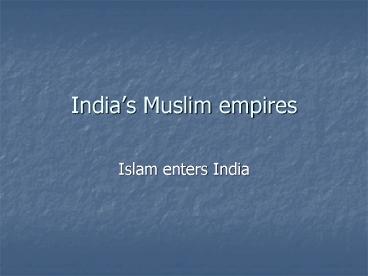India - PowerPoint PPT Presentation
1 / 21
Title:
India
Description:
India s Muslim empires Islam enters India The Delhi Sultanate Late 1100 s- Ghur s sultan- or Muslim ruler, defeats the Hindu army. Made Delhi his capital His ... – PowerPoint PPT presentation
Number of Views:156
Avg rating:3.0/5.0
Title: India
1
Indias Muslim empires
- Islam enters India
2
- After the Gupta empire fell in 550, rival princes
battled for control. - Despite the struggles, Indian culture flourished.
- Trade networks linked India to the Middle East,
Southeast Asia and China.
3
The Delhi Sultanate
- Late 1100s- Ghurs sultan- or Muslim ruler,
defeats the Hindu army. - Made Delhi his capital
- His successors organized a sultanate, or land
ruled by a sultan - The Delhi sultanate, 1206-1526, marked the
beginning of Muslim rule in Northern India
4
How did the Muslims win
- Muslim mounted archers had greater mobility than
the Hindu forces on war-elephants. - Hindu princes wasted resources by fighting each
other instead of fighting against a common enemy.
5
How did the Muslims win, cont.
- A large number of lower caste Hindus convert to
Islam and fight against Indian Hindus. - It was their only hope for a better life.
Islam
6
Muslim Rule Changes Indian Government and Society
- Sultans introduce Muslim traditions of
government. - Many Muslims moving to Delhi from Baghdad,
Persia - Persian art and architecture with flourish
7
The Sultans Lose Power
- 1398- Tamerlane invades India. (descendent to
Genghis Khan) - Thousands of artisans enslaved. They are to build
Tamerlanes capital at Samarkand. - Northern India is again fragmented into Hindu and
Muslim states.
8
Buddhism declines
- When the Muslims took over Northern India they
destroyed Buddhist monasteries - This lead to the decline of Buddhism in India
- With many Buddhists gone, now the Muslims and
Hindus will clash.
9
Muslim-Hindu differences
- Hindu
- Ancient religion
- Many sacred texts
- Prayed before statues representing many gods
- Polytheistic
- Islam
- Newer faith
- One single sacred text
- Muslims see statues as false gods
- Monotheistic
Interesting
10
Blending of cultures
- Muslim leaders grow more tolerant of their Hindu
subjects. - Hindus were allowed to practice their religion as
long as they paid a poll tax. - Some Rajahs- local Hindu rulers, were left in
place. - Indian Muslims would absorb elements of the Hindu
culture, such as marriage customs and caste
ideas. - Urdu- new language (blended Persian, Hindi and
Arabic)
11
Sikhism- new religion in N. India
- Blending of Islamic and Hindu beliefs
- Nanak, preached the unity of God, the
brotherhood of man, the rejection of caste, and
the futility of idol worship. - Sikhs would later become a military force.
12
Mughal India
- In 526 Babur- who claimed to be a descendent of
Genghis Khan and Tamerlane. - Leader of Turkish and Mongol armies that poured
into India.
13
Babur founds the Mughal Dynasty
- In little time, Babur gets rid of the Delhi
sultanate and sets up the Mughal dynasty. - Ruled from 1526-1857.
- Mughal is Persian for Mongul
14
Akbar the Great
- Chief builder of the Mughal empire is Baburs
grandson, Akbar. - Akbar created a strong central government.
15
Akbar
- He was a Muslim that won support from the Hindus
because of his policy of toleration. - Opened government jobs to Hindus of all castes.
- Hindu princes were partners in ruling the empire.
- Akbar would marry a Hindu princess.
16
More on Akbar
- Could not read or write.
- Consulted leaders of many religions.
- Wanted religious harmony and toleration
- Wants all to accept Indias diversity
- Modernized the army
- Introduced land reforms
17
Akbars successors
- Jahangir- Akbars son, would be a weaker leader
than his father. - Let his wife, Nur Jahan, run the government.
- She was an able leader and the most powerful
woman in Indian history until the 20th century.
18
Shah Jahan- Akbars grandson
- Highpoint of Indian literature and art comes
under Jahan - Married to Mumtaz Mahal
- She died at age 39 after having 14 children.
- Builds a tomb for her, Taj Mahal
19
(No Transcript)
20
Taj Mahal
- Designed by a Persian architect
- Domes and minarets reflected in clear blue
reflecting pools. - Verses from the Quran adorn the inside walls.
- The greatest monument of the Mughal empire.
21
More on the Taj Mahal
- Shah Jahan planned to build a twin structure as a
tomb for himself. - But before he could, his son seized the throne.
- Shah Jahan was kept imprisoned until his death.































